|
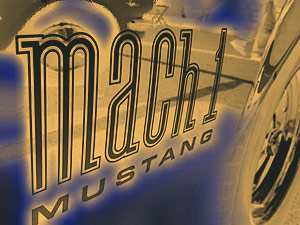
Aviation had influenced the automobile design since the early 50ies. Many a student
at the Art Center of Design School was influenced and tried to mix styling
elements of jet based aeroplanes with the more roadbound vehicles. Like Phil
Clark and his classmates and many others of the 50ies and early 60ies
classes. The dream
of flying on wheels led to a hype in setting up new land-speed records
around the world.
The jet aircraft development took mostly place from 1945 to 1955. In the US
jet aircrafts had a late start compared to british and german testing.
More interesting to know is however that North
American P51-B Mustangs were widely used as testbeads due to
their aerodynamic features.
Chuck Yeager succeded in October,14th 1947 in the Bell X1A named the "Glamorous
Glennis" to fly faster than sound for the first time.
On land the first serious attempt to break the sound barrier was made in
1978 with the Budweiser Rocket car, but it failed to do it both ways and
reached 739,666mph.
The Thrust SSC was the first roadbound vehicle that succeeded to match the
regulation for a Mach1 land speed record and that exactly on the 13th.
October 1997 with 764,168 and 760,135mp/h being registered on both runs.
What is the term Mach 1 Speed about?
The term Mach reaches back to Ernst Mach, a scientist born 1838 in
Austria. Ernst Mach published the first photo of the supersonic waves, that
a bullet creates, when travelling faster than the speed of sound.
Actually the speed of sound as Mach 1 is defined as 742mph at 32°F sea
level or 761mph at 59°F(15°C) sea level.
|
The Mach1 story started already
at Ford in 1959...
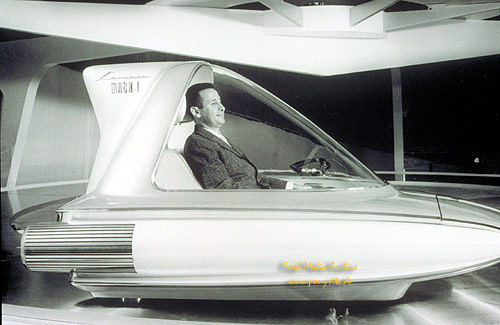
...with the Levicar concept
car. Note the "Captains" smiling while looking into the future
seeing a real cool ride ahead. Levicar actually stood for the levitation
character of the vehicle. Levicars have been a dream not only from Ford, but
also from GM in their Cars of the Future exhibition as well.
Eventually the Levicar theme has lead to Levicar
Unlimited and
magnetic levitation vehicles.
The idea of Levicars is still valid today or maybe even more important.
Read some comments about
it and a fictional
story by Ph.D Joshua Levin here
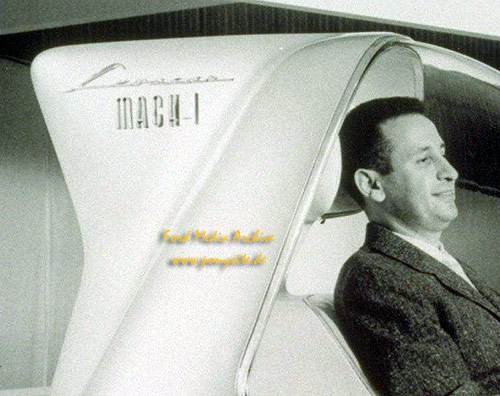
The Mach 1 emblem is
clearly visible and wasn't much altered for the later history making Mustang
variety. Probably the only thing that was kept ...aside from the same spirit.
|
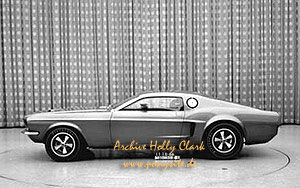
The Mach 1 as staged in the Ford Design
Centre in
December 1966
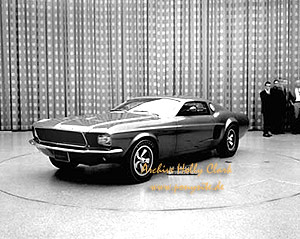
Pictures thanks to Holly Clark
Some pics from Wallace Wyss archive (provided
by Charlie McHose) of the interior of the Mach 1 show car haven't arrived in
time, but we hope to be able to show them soon.
Wally tells us, they are in his piles somewhere.
Reminds me of my own order.
|
The Mach I show car debut
in 1966
by Guest Editor Wallace
Wyss
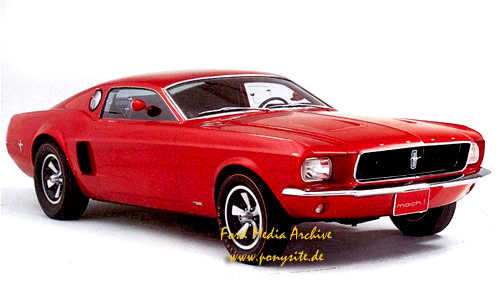
The first Mach I show car was introduced in
late 1966. It was
based on a stock Mustang body shell. The
purpose of it was to test out public reaction to race car like features.
For
instance, the side windows were fixed in place plexiglass like the GT40
race car. There was a toll window on each side to pay the toll on toll roads,
you could say.
Furthermore it featured huge air intake scoops ahead of the rear wheels, a
ducktail spoiler and twin racing flip-open gas caps in the roof section.
The headlights on the first
car were rectangular, maybe Cibie or Marchals from France.
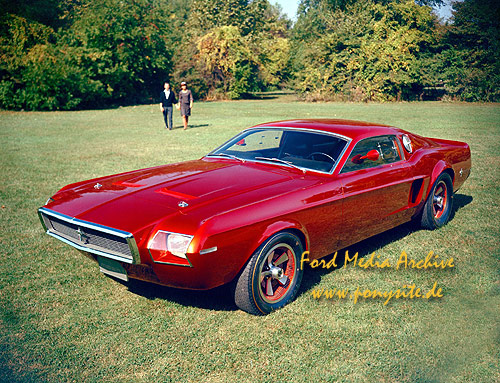
The second version of the same Mach 1 show car appeared slightly altered
at 1968 Ford shows. The headlights this
time had a plexiglass covering, angled in the
center ‘fairing” them in. This second version would have been illegal in the U.S. because at that time headlight coverings were illegal
and even the vaunted Jaguar E-type had to have its nice
see through glass headlight fairings removed.
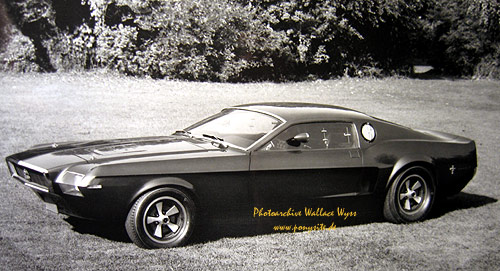
The side view showed an Indy 500 roadster style
traditional gas cap. In the
rear was four exhausts, a theme Ford has tried on various show cars
but never followed through with on production. Eventually it lead to the 69
Shelby exhaust tips, since the same designers had a word in that styling.
The car was fitted with a complete interior which
included two bucket seats that
were like upholstered fiberglass shells. The upholstery pattern was
similar to that of the GT40 with metal “grommets” for breathing holes.
Pete Stacey and Chuck McHose take credit for the design of the
car, they being the same two
who had been assigned to Shelby-American in May 1966 to
design the 1967 Shelby Mustang.
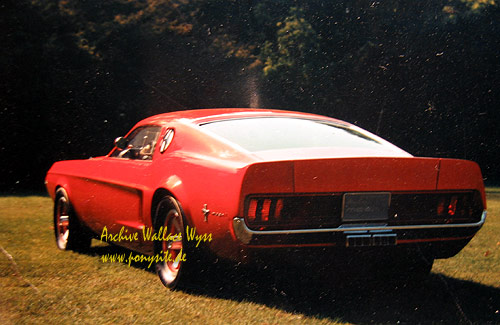
The wheels were special mag wheels on the car and they
were shod with Firestone 500
“Indy” wide ovals. These for-race-only tires were illegal on the
street because they did not have sufficient sidewall protection against curbs but they were used by hot rodders in the mid 60’s
nonetheless. In a way you can see this car had nothing
to do with Shelby because he was a Goodyear dealer and
would not have aligned himself with a show car using Firestone
rubber. In fact one suspects that Ford developed this car with an eye
toward having a musclecar to market that would not have any name connection
with Shelby.
The car was called the "Mach I" because this
was still an era of the cold war
when new fighter planes were touted on how fast they could go, "Mach
I" being roughly 750 mph or the speed of sound. I
may be wrong but I think the U.S. had at least one plane
that could go Mach 2 (the SR-71 Blackbird)
Was the Mach I a running car? Does it still survive? All we know
is that Ford subsequently put a production car in the
showroom called the Mach I but
alas it didn’t use anything of the candy apple red show car....
text by Wallace Wyss
|
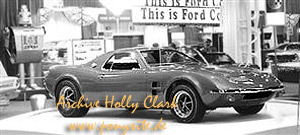
The MachII car as displayed at the 1967
Chicago Auto show
Picture thanks to Holly Clark Archive
|
The Mach II

The mid-engine Mach II is reported in many
books to have been personally
styled by Gene Bordinat, although I personally don't believe that. It looks
somehow based on the early 1964 GT44 concept
car, but is another proof that
Ford never left out the idea of creating a 2-seater sports car. Some
sources rather call it an engineering study created by the team of Roy Lunn
again, the same people, who worked on the Mustang I together.
Still the Mach II was during its development rather intended to be an
eyecatcher only. Shelbys designers obviously later adopted some things of its
concept for the Shelby Lone Star. Since people like Pete Stacey and Charlie
McHose were transferred to Shelby in mid 1966, the relation is not really a
surprise. However the Lone Star was constructed in England in late 1967 by
John Wyers Automotive Engineering. It's tubular chassis was a cross between a
427 Cobra and a GT40. Only one was ever sold - for $15000.
This Mach II shape was created starting already in 1966 and shown first time at
the Chicago 1967 Auto Show, nevertheless it was still around until 1970,
before it went out of sight.
Development Engineer Ed Hull combined a ZF five-speed transaxle with a Mustang
engine.
A square steel tube frame was added to the front end. The driveshaft tunnel
was used for pipes and water hoses. Radiator was still up front.
The rear suspension was constructed around the transaxles half-shafts
featuring additonal lower links with parallel trailing arms. Coil springs with
adjustable Koni shocks allowed stiffer control of the set-up.
Front disc brakes, a quick-ratio manual steering from the Mustang and Galaxie
drum brakes rear.
The early Monza design (at least quite visible in the 1964 Times magazine
about Iacocca) certainly had some influence on this car as well. GM raised his
eyebrowes during the launch, since its Astro II show car and the Aerovette
were quite close to this design.
One can speculate which designers signatures really lead to this car. In our
view it was a blend of the Mustang I with GT40 and GM styling elements. Now
you might have a clue
The Mach II study was followed by many other mid-engined styling studies, but
judged to have no potential for volume sales. Roy Lunn, while working
still at Kar Kraft (after the Boss 429 project) developped another Low
Investment Drive (LID) mid-engined 2-seater sports racer in 1971, that never
saw the light outside.
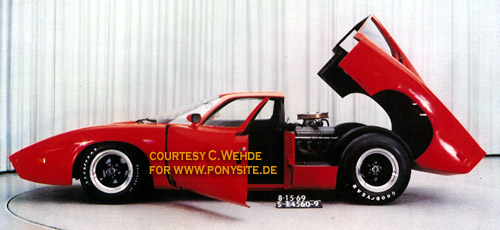
The Mach 2 C was developped in the race against the ASTRO II mid-engined GM
concept car. Franco Varani states, it never got beyond this fibreglass show
car, which is very likely due to the small sized air vents for the engine. The
Mach 2 C was shwon in the studios on 8-15-69. Picture courtesy Christian
Wehde's archive.
|
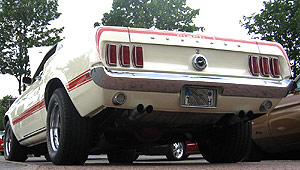
Another white 1969 with the red Mach 1 striping
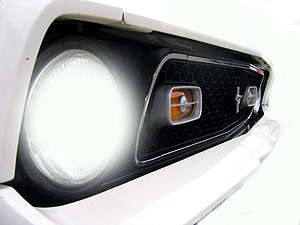
|
The Road Cars 1969 - 1973 Mach1
The Ford Total Performance Program
initiated the Mach 1 programm already with the 1966 Mach 1 showcar and led to
numerous design studies with the result of the 69 Mach 1 option.
Offered at
$3.139 dollar base price, it featured simulated rear quarter air scoops (which
was standard on all 69 Sportsroof). Mach 1's standard hood scoop was a
non-functional fiberglass scoop featuring built in turn signal indicators', but
many Mach1 buyers opted for the functional "Shaker" called hood scoop. Shaker because of its
vibrating, especially at high revs.
The base "Performance"
Mach 1 was equipped with a 351 cid engine and 250HP, the hood being tight down
with the hood locks, rather suitable for the optional 428 Cobra Jet, developed
under the leadership of Tom Feaheney.
Mach 1 suspension was developed by Matt Donner using the 1967 heavy-duty
set-up, but for the first time introduced the staggered mounting location of
the rear shocks in a serial street Mustang eliminating the previous widely
known wheel hop.
72458 Mach 1 were produced in 1969 acc. to Kevin Martis book "Mustang by
the Numbers" available via www.martiauto.com
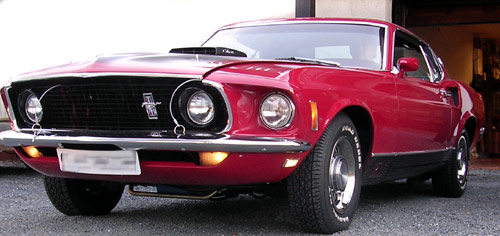
A one of one - truely unique Mach 1
-- my friends Svein Erik Aaseruds 1969 Super Cobra Jet Mach 1 T-5
Actually T-5s had no T-5 fender emblem on the Mach 1 due to the typical Mach 1
striping in the same location. Same applies of course to the Mustang script
for the US-version. This car is still in the process of a concours
restoration.
Mach 1 Engines in 1970 ranged from
the 351 cid 2-barrel V8 up to the 428 four barrel with ram air. Mach 1
suspension was also improved with a rear stabilizer bar. The 1970 Mach1
featured its own special grille with driving lamps.
The dull finish black center hood section, hood locks and the functional hood
scoop were carried over. Twin racing mirrors, pop-open gas cap and black
honeycomb rear panel made up the package.
In 1970 model style 40975 Mach1 left the
assembly lines.
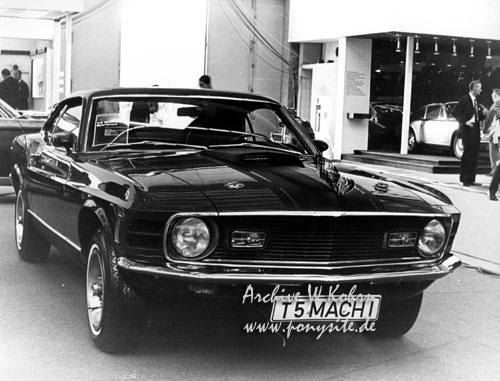
One of the first 1970 Mach1 T-5 as
displayed at the IAA Frankfurt show
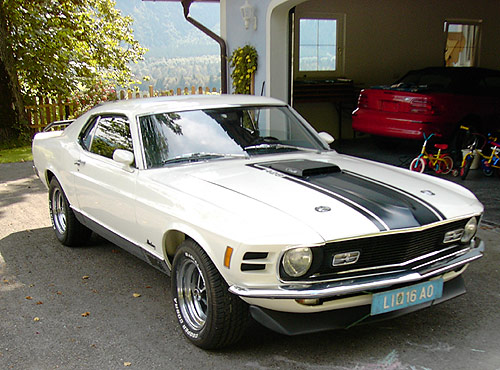
A clean white 1970 Mach 1 R-code from
Austria owned by Rony. John from the Mach1
Registry points to the fact that Magnum 500 rims were not original on
these cars, as well as the gas cap, which should be a pop-open style.
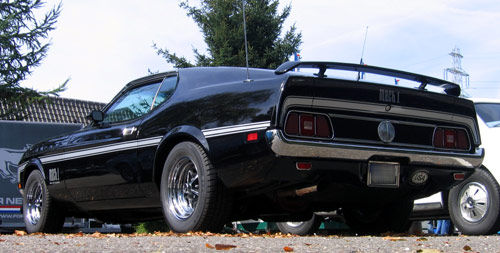
A very rare 1971 Mach1 429 Super Cobra
Jet - exported to Switzerland, owned by Rolf Rickes/Germany
Standard Mach 1 equipment in 1971
included the high-back-bucket seats, integrated front spoiler, honeycomb
grille with auxiliary lamps, dual exhausts and racing style exterior mirros.
The 429 CJ engine was a $436 option, but led to a 0-60mph acceleration of 6.5
seconds, not to bad for the so-called Big Body.
The Mach 1 option was available throughout 1972 and 1973.
Accurate numbers taken from Kevin Martis above recommended book are 36498 for
1971, 27675 for 1972 and 35439 for 1973.
Sidenote: No 71-73 Mach 1 convertibles were ever made, although some CVs were
ordered with the hood treatment and striping that leads some owners today to
the belief that they have something very exclusive. In fact they are nicely
done, but not Mach 1 convertible.
|
|
(Part II (1974-1978) and the Mustang IV Mach1 - TO FOLLOW)
|

















